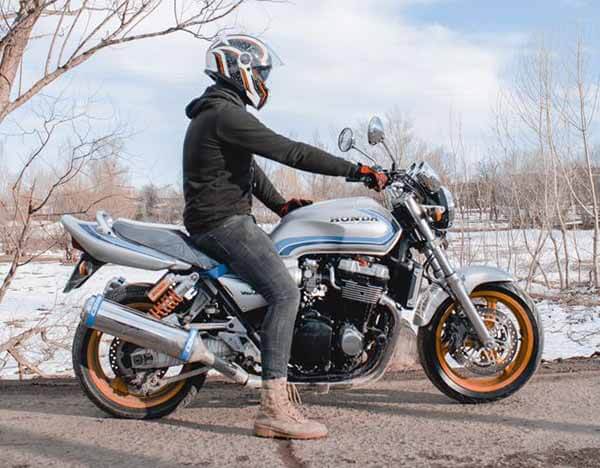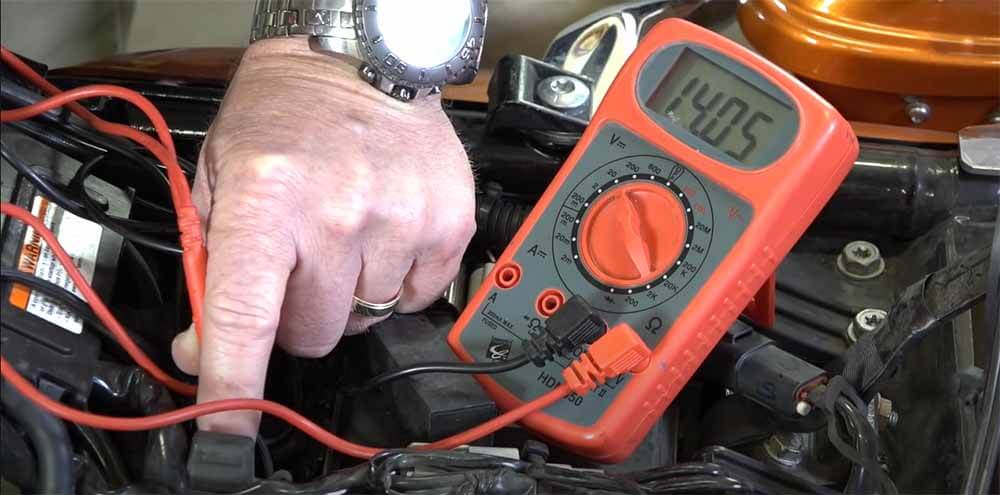When winter comes around, Canadians know it’s motorsports season. Snowmobiles simulate the joy of riding motorcycles. Of course, there are snow conversion kits for motorcycles, but they can cost an arm and a leg, not to mention they are useless if you plan to commute in the city. The truth is — there are limits to what a motorcycle can do in cold weather and those limits are imposed only by the rider’s tolerance and skill. And so, inevitably, we reluctantly park-in our KTM in for the winter and hope it still runs come spring. This begs the thousand-dollar question, how often should I start my motorcycle in winter?
Start and run your motorcycle for at least 15 to 30 minutes once a week during winter and ride it for at least 10-15 kilometers to maintain the battery and engine components. Make no mistake, frequent activity is as healthy for your bike as it is for you. But idling in the garage doesn’t qualify as exercise, just like couching your woke self isn’t! Once a week is an irreducible minimum: Any less than that, and you’ll be in for a slew of troubles. Actually, starting a motorcycle in the winter is doomed if you do and doomed if you don’t. Time to burst into a myth!
Two Reasons You Shouldn’t Idle Your Motorcycle During the Winter
A cold start is harsh on the motor, and if you don’t run it up to maximum operating temperature under load, moisture condenses out of the air forming water in areas where it shouldn’t be. If you don’t intend to ride the bike to burn off moisture and recharge your battery from that chilly crank, don’t bother, and here is why:
1. Simply Starting Your Motorcycle in the Winter Will Not Charge the Battery Enough
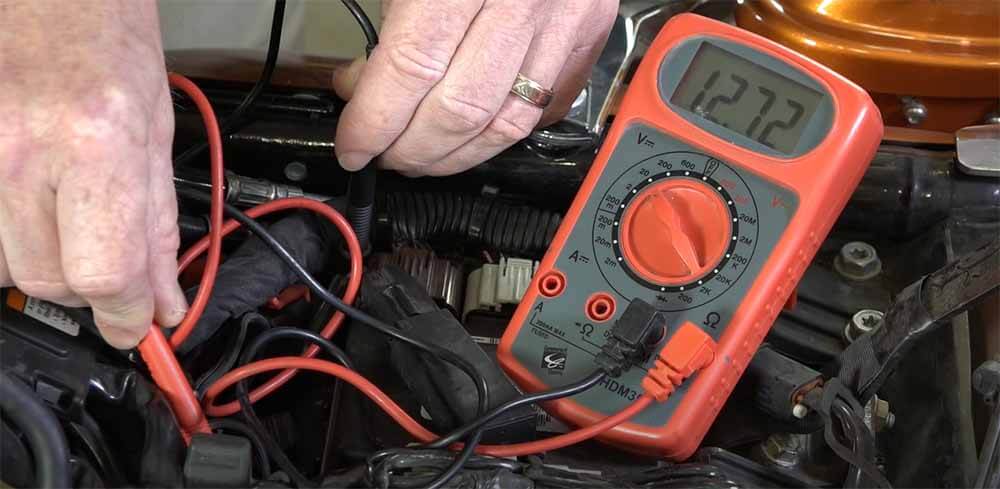
Motorcycles are unlike cars with respect to fast-charging batteries from their alternator. Although they do use engine power to replenish battery charge, it is usually more of a maintenance job than bottom-up charging — certainly not idle.
How the Battery Gets Charged When the Motorcycle Is Running
We can write a whole physics textbook on how electricity is generated, but the two underlying elements are a conductor moving in a magnetic field. Underline the word moving, as it is very important to how much voltage and hence current is generated. If the current is like water, voltage sources such as a motorcycle stator/magneto coil are the pumps that drive it, and voltage is like the potential difference created by pumping action.
Following the same analogy, the faster the pump moves (or in the case of electricity a conductor in a magnetic field), the more powerful the water jet (electrons constituting an electric current). This tells us that we need the coil to move at a substantial speed relative to the permanent magnet — usually used in bike engines to generate enough current to juice up our battery. Because the magneto is in turn rotated by the crankshaft, we need more engine RPMs to attain substantial charging voltage.
In practice, a motorcycle will charge a healthy battery fully after about 10-15 kilometers of riding at normal road speed. Specific time depends on make and model, but your manufacturer may not bother to specify. This is because battery charging systems on a bike are designed to automatically maintain the battery at the ideal voltage for the next starting session when the battery is heavily loaded by drawing a large current to the starter motor. Nominal voltage values are between 12.6V and 13.2V when turned off and 14V or 15V-ish when running.
The purpose of the battery on a motorcycle is only for starting and running the lights and appliances when engine rotation is lost or too slow. After starting, the voltage across the terminals should begin to climb steadily with an increase in RPM and then level out to a constant higher voltage at about 3000-5000 RPM. This is, by design, the charging range for your bike to top up the battery when riding.
But Why Is My Motorcycle Battery Not Charging?
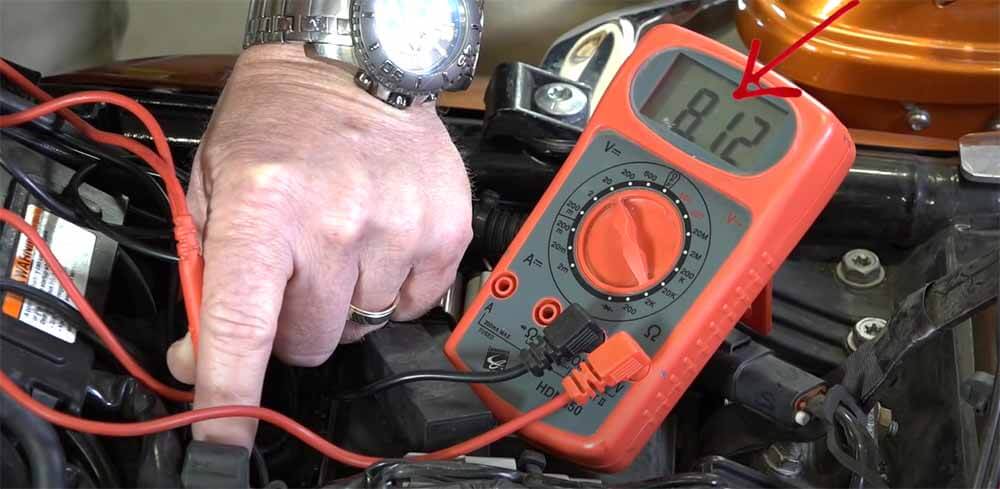
The most likely culprit for a motorcycle battery not charging is the stator or power regulator issue. This problem has other accomplices like a whining sound similar to an electric motor under load from the crankcase and failure to reach higher RPMs for the engine.
A power regulator, on the other hand, smoothens the jerky output of the alternator/stator so that your lights are not blinking due to fluctuating voltage. It ensures a steady supply of constant-ish voltage and current to various components. A failure here might result in, “Nothing seems to work, not even the dashboard.”
You May Like: Can You Leave Gas in the Motorcycle Over Winter?
Why Your May Struggle Charging the Motorcycle Battery During Idle
The nominal motorcycle battery voltage ranges between 14V and 15V-ish when running.
During idle, the motorcycle alternator generates only a small amount of excess current and raises the voltage only slightly, insufficient to replenish the charge used to start up the bike. The keyword is “little charging but not enough” to fully charge the battery, regardless of how much time and fuel is spent. A low battery will be brought to higher voltage but not nearly full unless you set your idle speed way too high — greater than 3,000 RPM.
Typical idling speeds are 1,000 to 1,300 RPM for most single-cylinder and multi-cylinder engines, which implies that a motorcycle coil will not supply charging voltage or current at idle. But why not rev the engine to the suitable 3,000 RPM range and keep it there for half an hour? Well, while technically this will charge your battery up, it creates its own slew of problems. Revving your idle bike for longer than 5 seconds begins to eat away at the engine as it’s not designed to be revved high in neutral.
Of course, we cannot claim that all bikes will charge up in any specified time or riding distance simply because the electrical component is different. Also, batteries have an Ah rating, which determines how large of a current can be drawn out of them and for how long and charging duration. Larger Ah batteries will be needed for engines that have a large starting load and hence a larger starter motor. For this reason, you need to replace your motorcycle battery according to the Ah rating.
How to Optimize Idle Charging
Let’s say your bike is in no position to go anywhere or you are not up to it. In that case, in the spirit of “something is better than nothing” you can still idle your bike to charge. To do this, you will put the bike in neutral and lock the throttle quarter to half-open at 3000-4000 RPM. Alternatively, if you have a carbureted bike, there will be an air/fuel screw that can adjust the idle speed usually on the side of the throttle body of the carburetor. The direction of adjusting speed may vary but generally advancing the screw reduces idle speed and vice versa.
For some motorcycles, the stator (generator inside the crankcase) can be tuned also, but this is not recommended if you are non-technical. Perhaps this could come in handy when you decided to go for a higher-rated battery.
What Causes the Motorcycle Battery to Die?
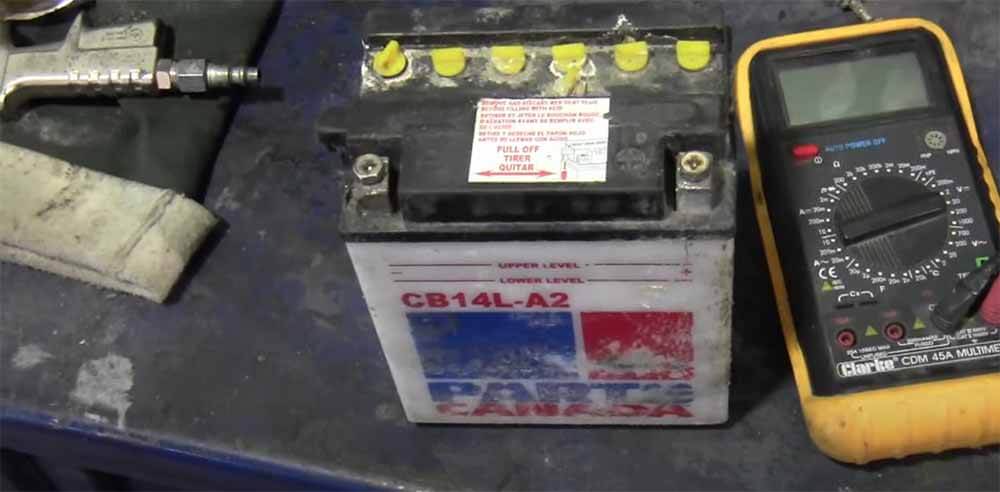
Motorcycle batteries generally die due to chemical changes when neglected i.e. undercharging, overcharging, and complete discharge. Let’s say your battery is a food reserve bank. Now, there are parasitic heists that you can reduce but not prevent entirely (by saying rats tunneling in) and there are major planned withdrawals. Even if you don’t make withdrawals often, you may still run out if the parasitic losses are high. At the same time, if you periodically withdraw but don’t replenish as often, soon there will be nothing left!
Similarly, batteries — especially when stored wired to the bike — have inevitable parasitic losses and major “withdrawals” each time a large starting current is drawn to turn the engine and start the bike. If charging does not occur, the battery will inevitably go flat. Battery chemistry does not allow them to remain discharged for long without going bad.
Other factors depend entirely on battery chemistry. Lithium and dry Calcium batteries can live longer without periodic care while wet lead-acid accumulators will sulfate and die in just a few days if left uncharged, undercharged, or overcharged.
So, if you plan on just starting the bike and not riding it, you are better off storing your motorcycle separately with a battery tender or completely disconnecting it and keeping it inside a controlled temperature environment and charging it in the spring.
How the Battery Takes the Cold…
The battery is one of the most unhappy components of the motorcycle when you decide to store it in the cold. For lithium cells, this can even break them, literally setting them on fire unless you have a special kind of compensation charger.
It doesn’t help that batteries face the hardest task of starting the motor when it is seized up by the cold contracted joints and the lubricant is viscous, making everything reluctant to move. This means the battery, already weak from weeks of neglect, has to dig deeper to turn the motor one last time before it crumbles to bits itself.
In short, you have more proof that starting a motorcycle to tend to the battery actually does more harm than good drawing monstrous currents, and leaving it dried out and flat.
Saving Your Motorcycle Battery from Yourself and the Cold
So, you are the biggest threat to your bike’s juice box if you remain ignorant of its chemistry, operating conditions, and whatnot. You had better store it separately, and at the very least, afford it some room in your heated spaces and simply ignore it for the winter. You can resist the urge to start your bike in the winter, which would cause further damage to the unit.
Too late? If you already bricked your battery, start by taking it from the crime scene to somewhere warmer. Now try to resuscitate it with the correct charger depending on its chemistry and capacity. You can use a multimeter and a load tester to confirm if it’s still dead or has survived. Better yet, test it out on the motorcycle this spring but don’t get your hopes high, chances are you are going to need a replacement.
Battery Tender for Motorcycles — Unsupervised Care!
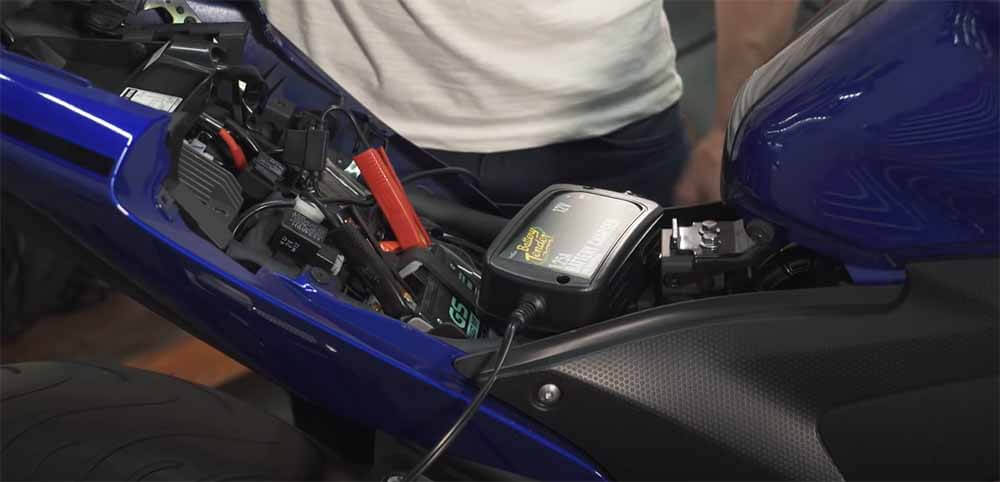
A battery tender is a charging device or mechanism, which plugs into your electrical mains and uses that power to replenish the charge on one or several motorcycles and car batteries or pretty much any suitable batteries. It is different from battery chargers in that battery chargers try to always charge the battery and consume power the whole time while a tender has an idling mode (also called floating state) where it stops to charge but monitors the battery for voltage drops and trickle charges it back to full when needed.
Obviously, battery maintainers are not built equally so be sure to check compatibility with your battery type because different batteries also appreciate different TLC. Some tenders like the Battery Tender® Junior 800 are multi-used with modes for lead-acid (wet), AGM, flooded, GEL, and lithium (LifePO4) units. Some tenders work on the battery, which is still connected to the bike parked near a power source, but they are designed for use on the bench.
2. Idling Your Motorcycle in Winter Might Be Killing the Engine More Than It Helps
With respect to extremely cold conditions, motorcycle engines take after their larger counterparts in four-wheelers. Fluids and mechanical members like bearings freeze still and have higher refusal to move to make turning the engine for cranking much harder.
Okay, now that we know motorcycle charging doesn’t generally do jack at idle, what if you started the bike and revved it up for an hour? That would certainly get the juices flowing once again, or would it?
Yes and no, that is a terrible idea, do not try that on your motorcycle. Here is why. The lubrication mechanisms in your bike are not optimal at subzero temperatures. In Siberia, they light a fire underneath trucks to melt the oil and fuels to get back on the road otherwise you have to have infinite fuel to idle the car all night or at the very least, a heated garage.
Motorcycle lubricants aren’t designed to lubricate nicely without fluid mobility supplied by heat. For the minutes before your motor is warmed up nicely, it’s basically grinding parts together, lacking enough lubrication in the upper compartments.
What Else Is There to Know About Motorcycle Engines and Cold Places?
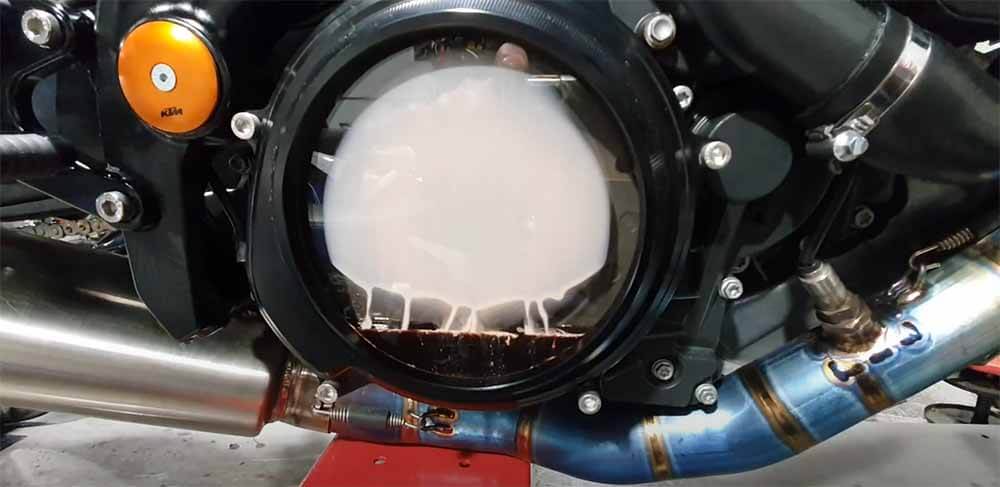
Enter condensation in engine oil — another interesting twist to this story. It occurs when you heat your engine vaporizing the water contents of air in your crankcase. This now has the ability to condense back into water inside the engine when the engine is turned off prematurely.
Ideally, you want to run the engine to a temperature high enough to dispose of this moisture by drying it out. This can be achieved by riding your bike rather than just idling it for a quick 15 minutes.
5 Great Excuses to Ride Your Motorcycle in the Cold — The Silver Lining
Hold on! Before you call me out on this, let me confess, that winter riding is not my piece of cake. Like many riders, I have zero tolerance for cold weather riding and prefer motorcycle winterization techniques that do not include riding on snow or extreme cold. That doesn’t mean that there are no benefits to riding all year, notably an everlasting battery if you can ride every day in winter! Here are more benefits of occasionally riding in the winter
- Maintains your battery by recharging it
- Bikes are performance machines that need exercise to stay operational
- Moving flushes out clogs, rust, and water moisture from the system
- It’s good for the tires, which tend to deform when left unused
- Avoid starting problems at the end of the off-season altogether
Final Thoughts: How Often Should I Start My Motorcycle in Winter?
Looking after your motorcycle in the off-season has neither to be expensive nor too complicated. It just takes a little more time and planning to give your torque beast the attention she deserves. Perhaps the best treatment is to take her out for a spin when the opportunity presents itself and conditions aren’t too harsh for riding.
If you simply have no time to ride your bike, you can still cover your bases by investing in fuel stabilizers, chargers, and battery tenders that can make restoring her to former glory less hectic. As a last resort, and only when you are lacking a wheel, you can start and idle your little gasoline-chugging monster to stir up her belly.
Information for this article was partially sourced and researched from the following authoritative Government, educational, corporate, and nonprofit organizations:
Motorcycles should not be on the road
About the Author:
Michael Parrotte started his career in the motorcycle industry by importing AGV Helmets into the North American market. He was then appointed the Vice President of AGV Helmets America, total he worked with AGV Helmets for 25 years. In addition, he functioned as a consultant for KBC Helmets, Vemar Helmets, Suomy Helmets, Marushin Helmets, KYT Helmets, and Sparx Helmets.
In 1985, He is the Founder of AGV Sports Group, Inc. cooperation with AGV Helmets in Valenza Italy
Click here for LinkedIn Profile: https://www.linkedin.com/in/parrotte/
Click here for complete AGV Helmet & AGVSPORT History https://agvsport.com/michael-parrotte
Click here for all AGV Sports Group Social Media information http://agvsport.info/
FM/AL

